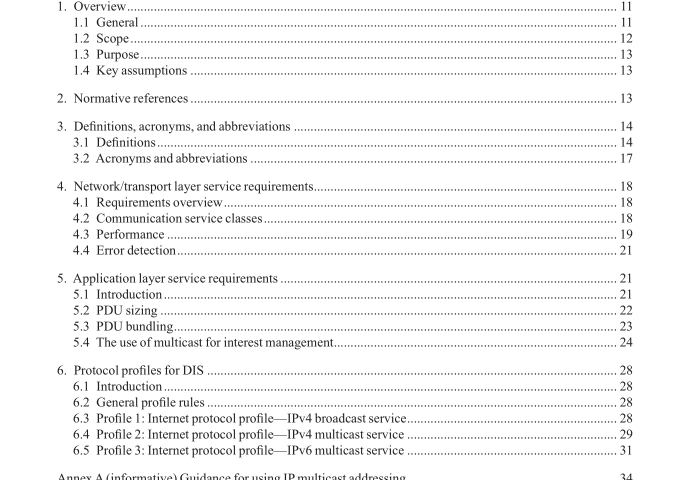IEEE 1278.2-2015 pdf download.IEEE Standard for Distributed Interactive Simulation (DIS)— Communication Services and Profles
application layer (Layer 7): The layer of the OSI Reference Model (ISO/IEC 7498-1: 1994) that provides the means for simulation applications to access and use the network’s communications resources.
best effort service: A communication service in which transmitted data is not acknowledged. Such data typically arrives in order, complete, and without errors. However, if an error occurs, or a packet is not delivered, nothing is done to correct it (e.g., there is no retransmission).
broadcast: A transmission mode in which a single message is sent to all network destinations, (i.e., one-to-all).
Broadcast is a special case of multicast. cell: A volume of a routing space defined by the intersection of a given segment on each dimension. Each cell is assigned one unique multicast address.
communication service: network software and infrastructure that provide the means to convey data between computers and processes.
data link layer (Layer 2): The layer of the OSI Reference Model that provides the functional and procedural means to transfer data between stations, and to detect and correct errors that can occur in the physical layer.
datagram: A unit of data that is transferred as a single, non-sequenced, unacknowledged unit.
dimension: An axis of a routing space. Dimensions are divided into two or more segments.
dimension criteria: The logical rules using protocol data unit (PDU) information to determine the segment on each dimension to which the PDU maps, ultimately determining the multicast address used to issue the PDU. distributed interactive simulation (DIS): A time-and-space coherent synthetic representation of world environments designed for linking the interactive, free-play activities of people in operational exercises. The synthetic environment is created through real-time exchange of data units between distributed, computationally autonomous simulation applications in the form of simulations, simulators, and instrumented equipment interconnected through standard computer communicative services. The computational simulation entities may applications can be present in one location or may can be distributed geographically.
exercise: See: simulation exercise.
ost computer: A computer that supports one or more simulation applications. All host computers participating in a simulation exercise are connected by network(s) including local-area networks (LANs), wide area networks (WANs), radio frequency links, etc.
interest management: A means to reduce bandwidth and processing resources by causing a protocol data unit (PDU) to be received by only the simulation applications that are interested in it.
local-area network (LAN): A communications network designed for a moderate size geographic area and characterized by moderate to high data transmission rates, low delay, and low bit error rates.
long-haul network: See: wide-area network.
multicast: A transmission mode in which a single message is sent to multiple network destinations, (i.e., one to many).
network layer (Layer 3): The layer of the ISO OSI Reference Model that performs those routing and relaying services necessary to support data transmission over interconnected networks.
network management: The collection of administrative structures, policies, and procedures that collectively provide for the management of the organization and operation of the network as a whole.
node: A general term denoting either a switching element in a network or a host computer attached to a network.IEEE 1278.2 pdf download.IEEE 1278.2-2015 pdf download
IEEE 1278.2-2015 pdf download

Leave a Reply